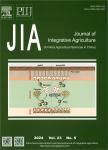How plant density affects maize spike differentiation, kernel set, and grain yield formation in Northeast China?
How plant density affects maize spike differentiation, kernel set, and grain yield formation in Northeast China?作者机构:Institute of Crop SciencesChinese Academy of Agricultural Sciences/Key Laboratory of Crop Physiology and EcologyMinistry of AgricultureBeijing 100081P.R.China Jilin Academy of Agricultural SciencesChangchun 130124P.R.China Heilongjiang Academy of Agricultural SciencesHarbin 150086P.R.China
出 版 物:《Journal of Integrative Agriculture》 (农业科学学报(英文版))
年 卷 期:2018年第17卷第8期
页 面:1745-1757页
核心收录:
学科分类:0710[理学-生物学] 0832[工学-食品科学与工程(可授工学、农学学位)] 0830[工学-环境科学与工程(可授工学、理学、农学学位)] 1004[医学-公共卫生与预防医学(可授医学、理学学位)] 0905[农学-畜牧学] 0906[农学-兽医学] 09[农学] 0901[农学-作物学] 0703[理学-化学] 0902[农学-园艺学] 0713[理学-生态学]
基 金:supported by the National Basic Research Program of China (2015CB150404) the National Natural Science Foundation of China (31671642) the Key Program of Science and Technology Department of Jilin Province, China (LFGC14205) the Innovation Project of Chinese Academy of Agricultural Sciences (CAAS-XTCX2016008)
主 题:corn dense planting spike differentiation anthesis-silking interval(ASI) kernel set
摘 要:A two-year field experiment was conducted to evaluate the effects of plant density on tassel and ear differentiation, anthesissilking interval(ASI), and grain yield formation of two types of modern maize hybrids(Zhongdan 909(ZD909) as tolerant hybrid to crowding stress, Jidan 209(JD209) and Neidan 4(ND4) as intolerant hybrids to crowding stress) in Northeast China. Plant densities of 4.50×104(D1), 6.75×104(D2), 9.00×104(D3), 11.25×104(D4), and 13.50×104(D5) plants ha-1had no significant effects on initial time of tassel and ear differentiation of maize. Instead, higher plant density delayed the tassel and ear development during floret differentiation and sexual organ formation stage, subsequently resulting in ASI increments at the rate of 1.2–2.9 days on average for ZD909 in 2013–2014, 0.7–4.2 days for JD209 in 2013, and 0.5–3.7 days for ND4 in 2014, respectively, under the treatments of D2, D3, D4, and D5 compared to that under the D1 treatment. Total florets, silking florets, and silking rates of ear showed slightly decrease trends with the plant density increasing, whereas the normal kernels seriously decreased at the rate of 11.0–44.9% on average for ZD909 in 2013–2014, 2.0–32.6% for JD209 in 2013, and 9.7–28.3% for ND4 in 2014 with the plant density increased compared to that under the D1 treatment due to increased florets abortive rates. It was also observed that 100-kernel weight of ZD909 showed less decrease trend compared that of JD209 and ND4 along with the plant densities increase. As a consequence, ZD909 gained its highest grain yield by 13.7 t ha-1on average at the plant density of 9.00×104 plants ha-1, whereas JD209 and ND4 reached their highest grain yields by 11.7 and 10.2 t ha-1at the plant density of 6.75×104 plants ha-1, respectively. Our experiment demonstrated that hybrids with lower ASI, higher kernel number potential per ear, and relative constant 100-kernel weight(e.g., ZD909) could achieve higher yield under dense planting in high latitude a



